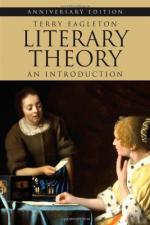
|
| Name: _________________________ | Period: ___________________ |
This quiz consists of 5 multiple choice and 5 short answer questions through Chapter 3, Structuralism and Semiotics.
Multiple Choice Questions
1. Eagleton argues that for Stanley Fish, what a text "does" to us is a matter of what we do to what?
(a) To the reader.
(b) To the author.
(c) To the critic.
(d) To the text.
2. According to Eagleton, what happens when literary theory becomes "turgidly unreadable"?
(a) "It is being untrue to the importance of its form."
(b) "It is being true to the importance of its form."
(c) "It is being untrue to its historical roots."
(d) "It is being true to its historical roots."
3. The English philosopher J. L. Austin saw language as what?
(a) Penultimate.
(b) Progressive.
(c) Performative.
(d) Pejorative.
4. For the Romantics, why was their vision of a just society was inverted into a nostalgia for an old and "organic" England?
(a) Because their vision of a just society was a corrupted version of industrial capitalism.
(b) Because they refused to give up their privilege as writers in industrial society.
(c) Because they lacked the means of transforming industrial capitalism.
(d) Because they were revolutionaries who were imprisoned in the old system.
5. How did the Romantic artist reflect her or his work in its detachment from history itself?
(a) Because she or he was seen as a major commodity who existed within society.
(b) Because she or he was seen as a minor commodity who existed on the margins of society.
(c) Because she or he was seen as a consumer of commodities who bought their goods for low pay.
(d) Because she or he was seen as a producer of commodities who sold their goods for high pay.
Short Answer Questions
1. Who is the key figure in the Victorian period Eagleton cites as "preternaturally aware of the needs of his social class"?
2. What date does Eagleton settle on as the "beginnings of the transformation which has taken over literary theory in this century"?
3. According to Eagleton, the sentence "this is awfully squiggly handwriting" from Knut Hamsun's "Hunger" tells him its literary because of what reason?
4. According to Viktor Shklovsky, what novel was "the most typical novel in world literature" because it impeded its own story-line so that it never gets off the ground?
5. In structuralism, the relationship between the sign and what it refers to is what?
|
This section contains 382 words (approx. 2 pages at 300 words per page) |

|




